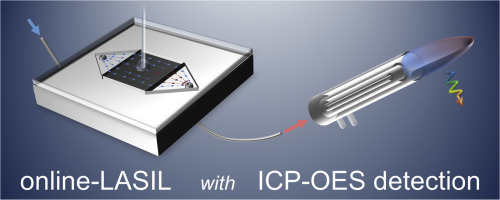当前位置:
X-MOL 学术
›
Anal. Chim. Acta
›
论文详情
Our official English website, www.x-mol.net, welcomes your feedback! (Note: you will need to create a separate account there.)
Online-LASIL: Laser Ablation of Solid Samples in Liquid with online-coupled ICP-OES detection for direct determination of the stoichiometry of complex metal oxide thin layers
Analytica Chimica Acta ( IF 6.2 ) Pub Date : 2018-02-01 , DOI: 10.1016/j.aca.2017.10.025 Maximilian Bonta , Johannes Frank , Stefanie Taibl , Jürgen Fleig , Andreas Limbeck
Analytica Chimica Acta ( IF 6.2 ) Pub Date : 2018-02-01 , DOI: 10.1016/j.aca.2017.10.025 Maximilian Bonta , Johannes Frank , Stefanie Taibl , Jürgen Fleig , Andreas Limbeck

|
Advanced materials such as complex metal oxides are used in a wide range of applications and have further promising perspectives in the form of thin films. The exact chemical composition essentially influences the electronic properties of these materials which makes correct assessment of their composition necessary. However, due to high chemical resistance and in the case of thin films low absolute analyte amounts, this procedure is in most cases not straightforward and extremely time-demanding. Commonly applied techniques either lack in ease of use (i.e., solution-based analysis with preceding sample dissolution), or adequately accurate quantification (i.e., solid sampling techniques). An analysis approach which combines the beneficial aspects of solution-based analysis as well as direct solid sampling is Laser Ablation of a Sample in Liquid (LASIL). In this work, it is shown that the analysis of major as well as minor sample constituents is possible using a novel online-LASIL setup, allowing sample analysis without manual sample handling after placing it in an ablation chamber. Strontium titanate (STO) thin layers with different compositions were analyzed in the course of this study. Precision of the newly developed online-LASIL method is comparable to conventional wet chemical approaches. With only about 15-20 min required for the analysis per sample, time demand is significantly reduced compared to often necessary fusion procedures lasting multiple hours.
中文翻译:

Online-LASIL:使用在线耦合 ICP-OES 检测对液体中的固体样品进行激光烧蚀,用于直接测定复杂金属氧化物薄层的化学计量
复杂金属氧化物等先进材料的应用范围很广,并且在薄膜形式方面具有更广阔的前景。确切的化学成分从根本上影响这些材料的电子特性,这使得对其成分的正确评估是必要的。然而,由于高耐化学性和薄膜绝对分析物含量低的情况,此过程在大多数情况下并不简单且非常耗时。常用的技术要么缺乏易用性(即,基于溶液的分析与之前的样品溶解),要么缺乏足够准确的量化(即固体取样技术)。一种结合了基于溶液的分析和直接固体采样的优点的分析方法是液体样品的激光烧蚀 (LASIL)。在这项工作中,表明使用新型在线 LASIL 设置可以对主要和次要样品成分进行分析,从而允许在将样品放入消融室后进行样品分析,而无需手动处理样品。在本研究过程中分析了具有不同成分的钛酸锶 (STO) 薄层。新开发的在线 LASIL 方法的精度可与传统的湿化学方法相媲美。每个样品的分析只需要大约 15-20 分钟,与通常需要持续数小时的融合程序相比,时间需求显着减少。结果表明,使用新型在线 LASIL 设置可以对主要和次要样品成分进行分析,从而在将样品放入消融室后无需手动处理样品即可进行样品分析。在本研究过程中分析了具有不同成分的钛酸锶 (STO) 薄层。新开发的在线 LASIL 方法的精度可与传统的湿化学方法相媲美。每个样品的分析只需要大约 15-20 分钟,与通常需要持续数小时的融合程序相比,时间需求显着减少。结果表明,使用新型在线 LASIL 设置可以对主要和次要样品成分进行分析,从而在将样品放入消融室后无需手动处理样品即可进行样品分析。在本研究过程中分析了具有不同成分的钛酸锶 (STO) 薄层。新开发的在线 LASIL 方法的精度可与传统的湿化学方法相媲美。每个样品的分析只需要大约 15-20 分钟,与通常需要持续数小时的融合程序相比,时间需求显着减少。在本研究过程中分析了具有不同成分的钛酸锶 (STO) 薄层。新开发的在线 LASIL 方法的精度可与传统的湿化学方法相媲美。每个样品的分析只需要大约 15-20 分钟,与通常需要持续数小时的融合程序相比,时间需求显着减少。在本研究过程中分析了具有不同成分的钛酸锶 (STO) 薄层。新开发的在线 LASIL 方法的精度可与传统的湿化学方法相媲美。每个样品的分析只需要大约 15-20 分钟,与通常需要持续数小时的融合程序相比,时间需求显着减少。
更新日期:2018-02-01
中文翻译:

Online-LASIL:使用在线耦合 ICP-OES 检测对液体中的固体样品进行激光烧蚀,用于直接测定复杂金属氧化物薄层的化学计量
复杂金属氧化物等先进材料的应用范围很广,并且在薄膜形式方面具有更广阔的前景。确切的化学成分从根本上影响这些材料的电子特性,这使得对其成分的正确评估是必要的。然而,由于高耐化学性和薄膜绝对分析物含量低的情况,此过程在大多数情况下并不简单且非常耗时。常用的技术要么缺乏易用性(即,基于溶液的分析与之前的样品溶解),要么缺乏足够准确的量化(即固体取样技术)。一种结合了基于溶液的分析和直接固体采样的优点的分析方法是液体样品的激光烧蚀 (LASIL)。在这项工作中,表明使用新型在线 LASIL 设置可以对主要和次要样品成分进行分析,从而允许在将样品放入消融室后进行样品分析,而无需手动处理样品。在本研究过程中分析了具有不同成分的钛酸锶 (STO) 薄层。新开发的在线 LASIL 方法的精度可与传统的湿化学方法相媲美。每个样品的分析只需要大约 15-20 分钟,与通常需要持续数小时的融合程序相比,时间需求显着减少。结果表明,使用新型在线 LASIL 设置可以对主要和次要样品成分进行分析,从而在将样品放入消融室后无需手动处理样品即可进行样品分析。在本研究过程中分析了具有不同成分的钛酸锶 (STO) 薄层。新开发的在线 LASIL 方法的精度可与传统的湿化学方法相媲美。每个样品的分析只需要大约 15-20 分钟,与通常需要持续数小时的融合程序相比,时间需求显着减少。结果表明,使用新型在线 LASIL 设置可以对主要和次要样品成分进行分析,从而在将样品放入消融室后无需手动处理样品即可进行样品分析。在本研究过程中分析了具有不同成分的钛酸锶 (STO) 薄层。新开发的在线 LASIL 方法的精度可与传统的湿化学方法相媲美。每个样品的分析只需要大约 15-20 分钟,与通常需要持续数小时的融合程序相比,时间需求显着减少。在本研究过程中分析了具有不同成分的钛酸锶 (STO) 薄层。新开发的在线 LASIL 方法的精度可与传统的湿化学方法相媲美。每个样品的分析只需要大约 15-20 分钟,与通常需要持续数小时的融合程序相比,时间需求显着减少。在本研究过程中分析了具有不同成分的钛酸锶 (STO) 薄层。新开发的在线 LASIL 方法的精度可与传统的湿化学方法相媲美。每个样品的分析只需要大约 15-20 分钟,与通常需要持续数小时的融合程序相比,时间需求显着减少。



























 京公网安备 11010802027423号
京公网安备 11010802027423号